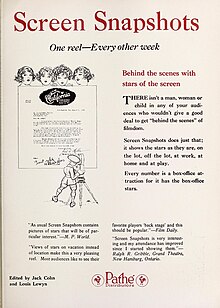| This article needs additional citations for verification. Please help improve this article by adding citations to reliable sources. Unsourced material may be challenged and removed. Find sources: "Screen Snapshots" – news · newspapers · books · scholar · JSTOR (May 2009) (Learn how and when to remove this message) |
Screen Snapshots are a series of documentary short subjects originally produced by Screen Snapshots Inc. and distributed first by Pathe Exchange (1919-1924) then by CBC Film Sales Corporation (1925-1929) later Harry Cohn's Columbia Pictures took over production and distribution of the series for the Sound Talkie Era from 1930 to 1958. They featured behind-the-scenes footage of Hollywood stars of the day at various Hollywood events or parties.
History

In 1919, Jack Cohn, brother of future Columbia president Harry Cohn, wanted short one-reel size films showing the reality of Hollywood. The two brothers created Hall Room Boys Photoplays, with Harry in Los Angeles to produce and Jack in New York for distribution. While Harry considered himself in charge of everything the company made, it was Jack's project and so he brought in Lewis Lewyn [de] to coproduce.
From about 1930, these short documentaries were almost exclusively written, produced, directed and narrated by Harriet Parsons, when she left Ralph Staub took over production responsibilities and Art Baker served as narrator until the series was discontinued in 1958. They usually ran for 9 or 10 minutes and were shown in cinema theatres like newsreels alongside main features.
Awards
Three of these documentary shorts were nominated for an Academy Award, Best Short Subject, One-reel, all produced by Staub. They are:
- Screen Snapshots Series 23, No. 1: Hollywood in Uniform (1944)
- Screen Snapshots' 50th Anniversary of Motion Pictures (1945)
- Screen Snapshots Series 25, No. 1: 25th Anniversary (1946)
References
- Citations
- "Jack Cohn Dead; Film Pioneer, 67". The New York Times. December 10, 1956. p. 31. Retrieved January 10, 2021.
- "Screen Snapshots".
- Dick 1993, p. 30.
- Dick 1993, p. 31.
- Dick 1993, p. 33.
- Works cited
- Dick, Bernard F. (1993). The Merchant Prince of Poverty Row: Harry Cohn of Columbia Pictures. University Press of Kentucky. ISBN 978-0-8131-1841-3.
External links
- Hollywood in Uniform at IMDb
- Screen Snapshots' 50th Anniversary of Motion Pictures at IMDb
- Screen Snapshots' 25th Anniversary at IMDb
- Ralph Staub at IMDb
This article about a documentary film about the arts is a stub. You can help Misplaced Pages by expanding it. |
This article about a short documentary film is a stub. You can help Misplaced Pages by expanding it. |
- Film series introduced in 1920
- English-language short documentary films
- American black-and-white films
- American short documentary films
- Columbia Pictures short films
- Documentary film series
- Documentary films about Hollywood, Los Angeles
- Films shot in California
- Arts documentary film stubs
- Short documentary film stubs